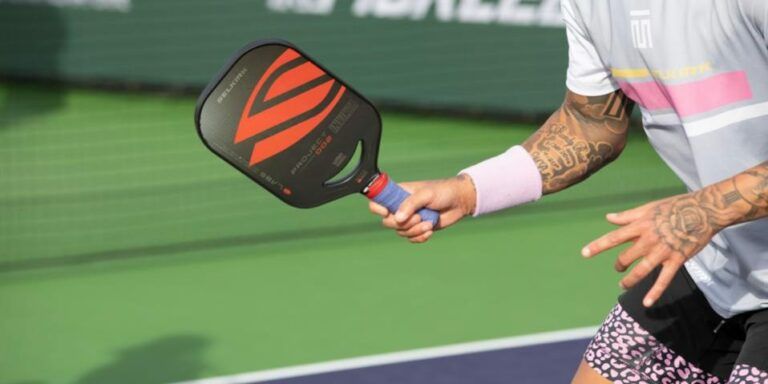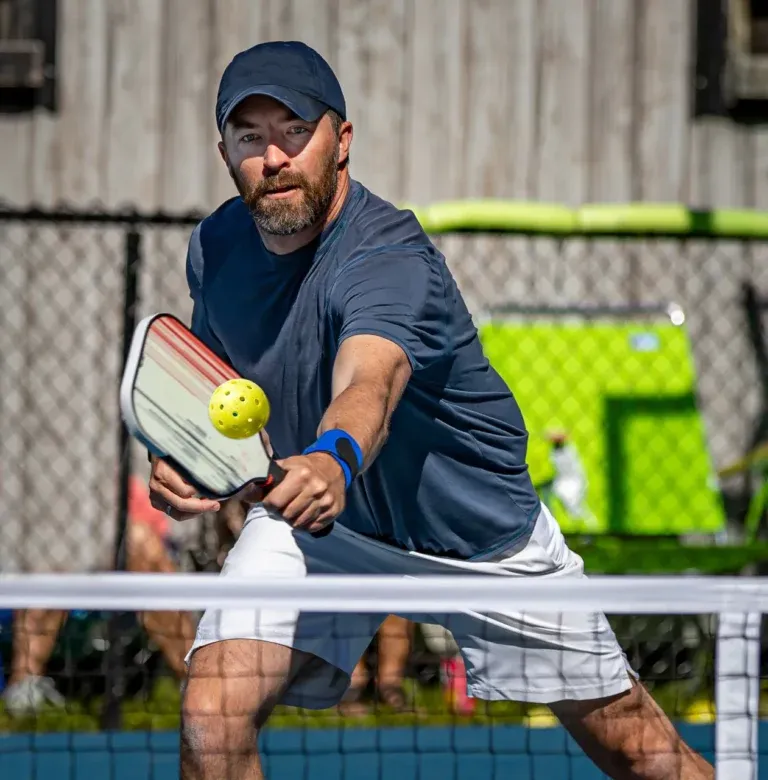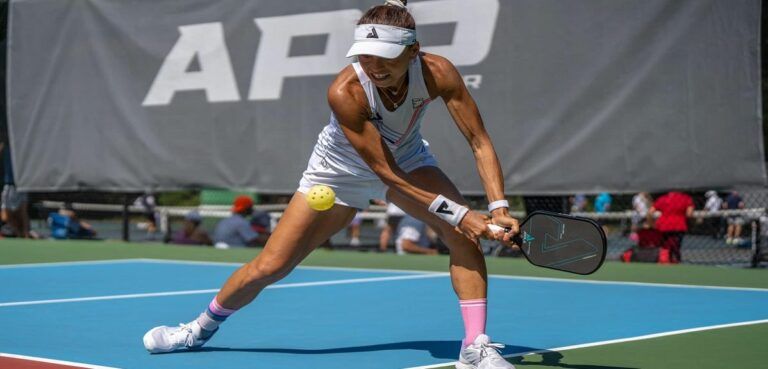Understanding pickleball grips
What is a pickleball paddle grip?
A pickleball grip refers to the way a player holds the paddle. Like a skilled musician who finds that perfect note, the right grip can unlock potential on the court. It is fundamental to how players execute shots, gain control, and generate power. As players advance in skill, their choice of grip may evolve, much like the journey from novice to expert in any domain. Selecting the correct grip based on your abilities and playing style can enhance your game significantly.
- Grip Influence: The way you grip your paddle affects shot execution, control, and power. A proper grip allows fluid transitions between different types of strokes and reduces the likelihood of mishits.
- Skill Level Transition: Each player's requirements change as they transition from beginner to advanced levels. Developing a deeper understanding of your playing style will help guide your grip selection.

Types of pickleball grips
Understanding the different types of grips is essential for anyone looking to improve their game. Each one has distinct advantages and disadvantages, much like the tools in a craftsman's workshop, each serving a unique purpose.
Continental Grip: Often referred to as the hammer grip, it allows players to execute a variety of shots without shifting hand positions. To achieve this grip, picture yourself shaking hands with your paddle, creating a firm but flexible hold. It's particularly well-suited for players who frequently utilize backhand shots and control-heavy plays like dinking.
- Advantages: Versatility for different shots, ease of transitioning between forehand and backhand.
- Disadvantages: Might not maximize power in certain heavy-hitting circumstances.

Eastern Grip: Resembling a handshake position, this grip channels both control and power. To adopt it, place the base knuckle of your index finger on the third bevel of the paddle. This grip shines for players who want to mix offensive and defensive strokes effectively.
- Advantages: Offers suitable control for both forehand and backhand.
- Disadvantages: Can require grip adjustments based on shot type, which may confuse beginners.

Western Grip: Known as the frying pan grip, it is ideal for generating topspin on forehands. Place your palm facing downwards, akin to holding a frying pan. This grip allows for aggressive shots but often necessitates grip changes for backhands.
- Advantages: Excellent for powerful topspin shots.
- Disadvantages: Less effective for backhand shots, requiring additional practice.
Understanding these basic types can help players select the best grip for their individual style while enhancing overall performance on the court.

Choosing the right grip for you
Selecting the appropriate grip for your personal style is a crucial step in your pickleball journey. It's not just about flavor or personal taste, akin to selecting the perfect seasoning for a dish; each grip aligns with different playing styles and preferences.
Factors to consider
Several considerations can help guide you in your decision-making process.
- Hand Size and Comfort: Larger hands might gravitate towards grips with more volume, while smaller hands may benefit from thinner grips. Finding comfort is paramount, as it directly influences your play.
- Playing Style: Are you a power player who thrives on aggressive shots, or do you prefer a more controlled, tactical approach? Understanding your style can aid in identifying the grip that complements your strengths.
- Shot Preference: Analyzing which strokes you excel at forehands, backhands, volleys can clarify your grip choice. Players favoring aggressive forehands might lean towards the Western grip, while those focusing on control might prefer the Continental grip.

Grip recommendations by skill level
As players progress, different grips may be more suitable.
- Beginners: Starting with the Eastern grip is often recommended due to its versatility and ease of learning. Players can then gain confidence while exploring various shots.
- Intermediate Players: Explore Continental or Western grips based on your evolving play style. This phase is about experimentation and adapting to your unique playing rhythm.
- Advanced Players: Consider developing a nuanced understanding of grip adjustments during play. At this level, grasping the advantages and disadvantages of different grips becomes essential for performance optimization.
Grip size: finding the perfect fit
Once you have determined which grip style resonates with you, it's vital to find the correct grip size. A match that is too large or too small can lead to discomfort and even injurious conditions, like tennis elbow.

Why grip size matters
Grip size impacts your ability to control shots and deliver power effectively. A grip that’s too small can lead to instability and mishits, while one that's too large can cause unnecessary tension and fatigue. As with a well-tailored suit, the right fit allows for comfort and freedom of movement.
Determining your ideal grip size
Finding the perfect grip size involves a few methods:
- Height Test: Players can refer to a chart that suggests grip sizes based on their height. Generally, shorter players may need a smaller grip, while taller players may require larger grips.
- Finger Length Test: Measure grip size by assessing the length of your fingers in relation to the handle of the paddle.
- Index Finger Test: Although more common in tennis, it involves holding the paddle and placing your index finger against your thumb to gauge fit. Keep in mind that this method may not translate perfectly to pickleball.
Adjusting grip size
If your current grip doesn’t feel right, several options available include:
- Overgrips: Use these thin wraps to increase grip size. They provide additional cushioning and can be easily replaced when worn.
- Replacement Grips: For a more permanent adjustment, consider replacing the existing grip with a thicker one.
- Grip Tape: This option adds thickness safely and inexpensively, allowing further customization based on your preferences.
Mastering grip pressure
The pressure with which you grip your paddle can significantly impact control and shot performance. Every player must learn to find a balance that enhances gameplay without resulting in tension or fatigue.

The importance of a relaxed grip
Holding the paddle too tightly can hinder your sensitivity to subtle changes in the game. The principle of the “4 out of 10” grip pressure suggests that a relaxed grip enhances touch and control, enabling players to respond to the game organically.
Benefits of proper grip pressure
Achieving the right grip pressure is fundamental for consistent shot performance. A relaxed grip allows for:
- Shot Consistency: Improved control leads to more reliable shots, cornered by precision.
- Quicker Reactions: Swift responses to opponents’ actions become more automatic.
- Soft Touch for Dinks and Volleys: Touch plays a critical role in executing finesse shots effectively without over-hitting.
Techniques for developing grip pressure control
To cultivate grip pressure control, players should engage in practice drills focusing on varying their grip during play.
- Practice Drills: Consider exercises that engage different levels of grip pressure with specific shots to promote awareness.
- Pay Attention: Cultivate the habit of monitoring your grip pressure as you play.
- Seek Feedback: Collaborate with coaches or experienced players to gain insights and foster improvement in grip control.
Advanced grip techniques and strategies
As players become more adept at the game, understanding advanced techniques for grip manipulation can elevate their performance.
Grip changes during play
In pickleball, time is limited for making grip changes compared to tennis. However, there are key situations where subtle adjustments can influence performance.
- When to Change Grips: Recognizing moments during a match like transitioning between serving and returning where grip adjustments would benefit your execution.
Two-handed backhand
The two-handed backhand technique provides additional stability and power, particularly beneficial for players utilizing grips like the Western grip, which can weaken traditional backhands.
- Technique: Align your hands optimally for improved control while maintaining swing fluidity.

Finger placement on paddle face
Originating from table tennis, this technique aids control when striking the ball.
- While it can enhance precision, there’s also the added risk of injury if your fingers are accidentally struck during play.
Grip strategies for doubles play
Communication between partners regarding grip styles is essential for maximizing gameplay. Different grips can facilitate offensive plays and understand potential changes during highly dynamic situations, enhancing synchronization and strategy.
Grip maintenance and customization
Maintaining and customizing your grip can significantly affect your game.
Pickleball grips vs. overgrips
Understanding the difference between grips and overgrips enhances your decision-making process regarding replacements and upgrades.
- Grips: Generally thicker and designed for longevity.
- Overgrips: Typically thinner and used for comfort or for adding a layer of cushioning.
Replacing a pickleball grip
When it’s time for a grip replacement, follow a simple step-by-step process.
- Removing the Old Grip: Carefully peel off the old grip without damaging the handle.
- Applying the New Grip: Securely wrap the new grip, ensuring the edges align with the beginning of the paddle handle.
- Finishing Tape: Use finishing tape to secure the grip in place and enhance durability.
Adding a pickleball overgrip
Incorporating an overgrip provides added cushioning, comfort, and control.
- Step-by-Step: Stretch the overgrip while applying, overlapping slightly for secure coverage.
Customizing grip feel
The material and construction of grips can vary, offering different levels of tackiness, sweat absorption, and cushioning options. Choose based on your play style, preferences, and specific conditions you face during matches.
Common grip mistakes and how to avoid them
Awareness of common grip errors can lead to improved play quality and reduced injury risks.
- Gripping too tightly: The “death grip” can compromise control, fatigue players, and create tension in the arms and shoulders.
- Incorrect grip placement: Common errors in grip positioning whether on the Continental, Eastern, or Western grips can lead to erratic performance. Regularly check your grip to ensure it aligns with the intended position to enhance effectiveness.
- Neglecting grip maintenance: Worn grips can become slippery and compromise performance. Developing a replacement schedule can go a long way in ensuring that you maintain optimal grip conditions.
- Troubleshooting grip issues: Even seasoned players can face grip-related problems. Understanding common issues can help you identify the problem swiftly, enabling you to return to the game efficiently.
- Tennis elbow and grip: Improper grip size or technique can lead to conditions like tennis elbow. Ensuring the right grip dimensions as well as technique is critical in prevention.
- Loss of control: If you find yourself mishitting frequently, your grip might require adjustment. Analyze shot consistency and fine-tune your grip technique for improved outcomes.
- Lack of power: If shots feel weak, assessing your grip technique is essential. Learning to maximize your grip potential can dramatically increase shot power, enhancing overall gameplay.
In conclusion, mastering your grip technique doesn't just elevate your game; it transforms your entire playing experience. By taking the time to understand the intricacies of different grip styles, sizes, pressures, and techniques, you empower yourself to command your paddle with unparalleled confidence and skill. Whether you're a beginner just dipping your toes in the pickleball waters or an advanced player seeking to refine your performance, every player has something new to learn about their grip. So embrace the journey, practice diligently, and let the power of your grip translate into excellence on the court.










